Comparison of HepaRG cells following growth in proliferative and differentiated culture conditions reveals distinct bioenergetic profiles
- PMID: 30755072
- PMCID: PMC6422474
- DOI: 10.1080/15384101.2019.1578133
Comparison of HepaRG cells following growth in proliferative and differentiated culture conditions reveals distinct bioenergetic profiles
Abstract
HepaRG is a proliferative human hepatoma-derived cell line that can be differentiated into hepatocyte-like and biliary-like cells. Differentiated HepaRG cultures maintain key hepatic functions including drug transporters and xenobiotic-metabolizing enzymes. To gain insight into proliferative and differentiated HepaRG metabolism we profiled various bioenergetic parameters and investigated cell culture levels of adenosine triphosphate (ATP), lactate, and lactate dehydrogenase (LDH) activity. Compared to differentiated-derived HepaRG, cells from proliferative cultures had increased basal and ATP-linked respiration and decreased maximal and spare respiratory capacities. Basal ATP levels but not lactate or LDH activity were increased in samples from proliferative-derived compared to differentiated-derived HepaRG. Further extracellular acidification rate (ECAR) experiments revealed parameters associated with glycolysis and oxidative phosphorylation. Under basal conditions, cells derived from both cultures had similar ECARs; however, under stressed conditions, proliferative-derived HepaRG had increases in ECAR capacity and apparent glycolytic reserve. The biguanide metformin has been reported to protect differentiated HepaRG against acetaminophen (APAP)-induced cell injury, as well as offer protection against bioenergetic deficiencies; therefore, we studied the outcome of exposure to these drugs in both culture conditions. Proliferative- and differentiated-derived cells were found to have distinct mitochondrial bioenergetic alterations when exposed to the hepatotoxic drug APAP. Metformin offered protection against loss of APAP-induced cellular viability and prevented APAP-induced decreases in bioenergetics in differentiated- but not proliferative-derived HepaRG. Distinguishingly, treatment with metformin alone reduced ATP-linked respiration, maximal respiratory capacity, and basal respiration in proliferative-derived HepaRG. Our results support that HepaRG represents an appropriate model to study drug-induced bioenergetic dysfunction.
Keywords: Extracellular flux analysis and bioenergetics; pharmacological stressors; proliferative and differentiated HepaRG.
Figures
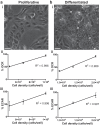
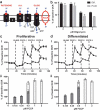
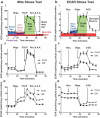


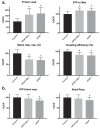
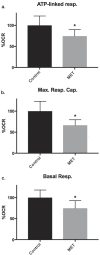
Similar articles
-
The antiretroviral 2',3'-dideoxycytidine causes mitochondrial dysfunction in proliferating and differentiated HepaRG human cell cultures.J Biol Chem. 2021 Jan-Jun;296:100206. doi: 10.1074/jbc.RA120.014885. Epub 2020 Dec 31. J Biol Chem. 2021. PMID: 33334881 Free PMC article.
-
Toxicogenomics-based prediction of acetaminophen-induced liver injury using human hepatic cell systems.Toxicol Lett. 2016 Jan 5;240(1):50-9. doi: 10.1016/j.toxlet.2015.10.014. Epub 2015 Oct 20. Toxicol Lett. 2016. PMID: 26497421
-
Targeting metabolic flexibility by simultaneously inhibiting respiratory complex I and lactate generation retards melanoma progression.Oncotarget. 2015 Nov 10;6(35):37281-99. doi: 10.18632/oncotarget.6134. Oncotarget. 2015. PMID: 26484566 Free PMC article.
-
The human hepatoma HepaRG cells: a highly differentiated model for studies of liver metabolism and toxicity of xenobiotics.Chem Biol Interact. 2007 May 20;168(1):66-73. doi: 10.1016/j.cbi.2006.12.003. Epub 2006 Dec 16. Chem Biol Interact. 2007. PMID: 17241619 Review.
-
Lactic acid: The culprit behind the immunosuppressive microenvironment in hepatocellular carcinoma.Biochim Biophys Acta Rev Cancer. 2024 Sep;1879(5):189164. doi: 10.1016/j.bbcan.2024.189164. Epub 2024 Aug 2. Biochim Biophys Acta Rev Cancer. 2024. PMID: 39096976 Review.
Cited by
-
Our current understanding of the biological impact of endometrial cancer mtDNA genome mutations and their potential use as a biomarker.Front Oncol. 2024 Jun 27;14:1394699. doi: 10.3389/fonc.2024.1394699. eCollection 2024. Front Oncol. 2024. PMID: 38993645 Free PMC article. Review.
-
Assessing the mitochondrial safety profile of the molnupiravir active metabolite, β-d-N4-hydroxycytidine (NHC), in the physiologically relevant HepaRG model.Toxicol Res (Camb). 2024 Feb 7;13(1):tfae012. doi: 10.1093/toxres/tfae012. eCollection 2024 Feb. Toxicol Res (Camb). 2024. PMID: 38328743 Free PMC article.
-
Analysis of Mitochondrial DNA Polymorphisms in the Human Cell Lines HepaRG and SJCRH30.Int J Mol Sci. 2019 Jul 2;20(13):3245. doi: 10.3390/ijms20133245. Int J Mol Sci. 2019. PMID: 31269646 Free PMC article.
-
Analysis of Human Mitochondrial DNA Content by Southern Blotting and Nonradioactive Probe Hybridization.Curr Protoc Toxicol. 2019 Jun;80(1):e75. doi: 10.1002/cptx.75. Epub 2019 Apr 14. Curr Protoc Toxicol. 2019. PMID: 30982231 Free PMC article.
-
The antiretroviral 2',3'-dideoxycytidine causes mitochondrial dysfunction in proliferating and differentiated HepaRG human cell cultures.J Biol Chem. 2021 Jan-Jun;296:100206. doi: 10.1074/jbc.RA120.014885. Epub 2020 Dec 31. J Biol Chem. 2021. PMID: 33334881 Free PMC article.
References
Publication types
MeSH terms
Substances
Grants and funding
LinkOut - more resources
Full Text Sources
Other Literature Sources
